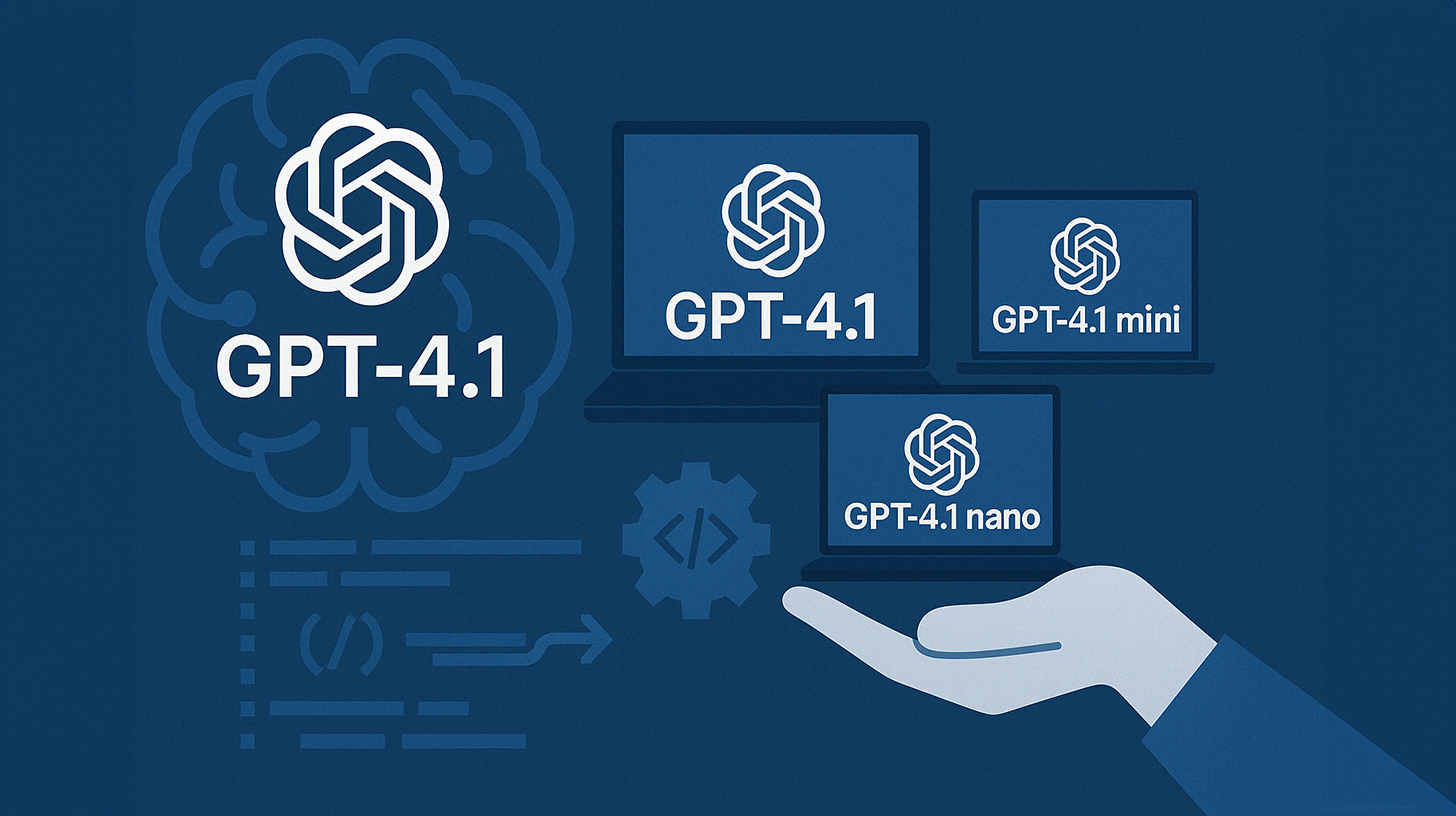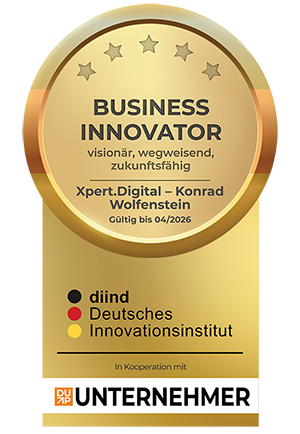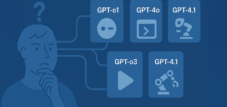Published on: April 17, 2025 / update from: April 17, 2025 - Author: Konrad Wolfenstein

AI model GPT-4.1 & Mini & Nano from Openai: Programming boost for software development-the end of GPT-4.5? - Image: Xpert.digital
Openai lowers prices and massively improves GPT-4.1-the new AI generation can really!
GPT-4.1 in detail: All innovations and improvements at a glance
Openaai has presented a significant further development of its AI technology: The GPT-4.1 model family represents important progress in mechanical language processing and offers significant improvements with the simultaneous reduction in costs. The new model line comprises three variants with different performance features and price levels, all with an extended state of knowledge until June 2024. The models are particularly characterized by progress in the areas of programming, more detailed follow -up and an improved understanding of extensive contexts.
The GPT-4.1 model family is only available via the API and is primarily aimed at developers. These models are not accessible directly in the Chatgpt user interface.
Suitable for:
The three variants of the GPT-4.1 family
The new model family consists of three different variants, each of which has been optimized for different applications and requirements:
GPT-4.1: The flagship model
GPT-4.1 represents the most powerful model of the series and is primarily aimed at professional software developers and demanding applications. It offers the highest intelligence of the family with an evaluation of 4/4 according to the OpenAis internal scale and is specially tailored to complex tasks. The model is particularly suitable for scientific research, the analysis of complex data records, the development of demanding software solutions and the creation of nuanced creative content. Thanks to its outstanding ability to generate and revise program code, GPT-4.1 positions itself as a leading model for coding applications.
GPT-4.1 Mini: The balanced all-rounder
GPT-4.1 Mini offers a balanced balance between intelligence (rating 3/4), speed (4/5) and costs. It represents significant progress in smaller models and even exceeds the previous GPT-4O in many benchmarks. With a speed that is almost twice as high as that of the predecessor, and costs that are up to 83% lower, this model positions itself as a versatile all -rounder for a wide range of applications. GPT-4.1 Mini achieves a performance comparable to GPT-4O, but with less latency and significantly reduced costs.
GPT-4.1 Nano: Efficient lightweight
GPT-4.1 Nano is the fastest and most cost-effective model of the family and has been developed for latency-critical or particularly cost-sensitive applications. It is ideal for simpler tasks such as classification, auto completion and information extraction. Despite its compact size, it supports the full context window of one million tokens and provides impressive results in specific benchmarks such as MMLU (80.1%) and GPQA (50.3%).
Technical improvements and performance increases
The GPT-4.1 model family brings significant technical improvements to the previous models:
Extended context window
All three models of the GPT-4.1 family support an extended context window of up to one million tokens, which corresponds to an eight-fold increase compared to previous versions. This expansion enables the processing of very extensive documents or code base in a single round-for comparison: the entire React source code would fit eight times in this context. The models can therefore process up to around 750,000 words in a single request.
Improved programming and coding skills
GPT-4.1 is characterized by significantly improved programming and coding skills. In the SWE-Bench Verified Benchmark, the model reaches an impressive score of 54.6%, which represents an improvement of 21.4 percentage points compared to GPT-4O and 26.6 percentage points compared to GPT-4.5. The models can master more complex programming tasks and create more precise code in various programming languages. Particularly noteworthy is the ability of the front-end coding with minimal post-processing, with human evaluators preferring the result of GPT-4.1 in 80% of the cases.
Optimized follow -up of instructions
One of the outstanding improvements to the GPT-4.1 family is the more precise compliance of instructions. On the multiceletry benchmark, which measures the ability to comply with instructions, GPT-4.1 achieves 38.3%, which corresponds to an increase of 10.5 percentage points compared to GPT-4O. With Openais Internal Instructance Following Test (Hard Subset), GPT-4.1 achieves an impressive 49.1% compared to only 29.2% in GPT-4O. In practice, this means that GPT-4.1 is much better in compliance with orderly steps, rejecting incorrect inputs and responding in the desired format.
Competition comparisons in the benchmark context
The performance of the new models can be quantified using various benchmarks:
Coding benchmarks
In the SWE-Bench Verified Benchmark, which includes 500 of people as a solvable classified programming tasks, GPT-4.1 achieves an impressive result with 54.6%. Although it remains behind comparable models from Google (Gemini 2.5 Pro) and Anthropic (Claude 3.7 Sonnet), both of which are around 63%, it clearly exceeds other Openai models: GPT-4O (November 2024) reached 33%, GPT-4.5 38% and Openaai O3-Mini 49%.
At Aider's Polyglot Benchmark, which tests the ability to revise code in various programming languages, GPT-4.1 achieves about 53%of the 225 problems, which lies behind Openaai O1 and O3-Mini (about 60%each), but before GPT-4O (18%).
Instruction following benchmarks
GPT-4.1 also shows considerable progress in the area of instruction compliance. With IFEVAL, which checks compliance with clearly defined performance requirements, GPT-4.1 87.4%achieves a significant improvement compared to GPT-4O with 81%. These improvements include various aspects of the instructions for instructions, including format requirements, negative instructions, orderly instructions, content requirements and ranking.
Long context benchmarks
With video mm, a benchmark for multimodal long-context understanding, GPT-4.1 sets a new benchmark with 72.0% in the “Lang, without subtitles” category, which is an improvement of 6.7 percentage points compared to GPT-4O. In the Graphwalks-Benchmark, which tests multi-stage conclusion in long contexts, GPT-4.1 reaches 61.7%-a clear jump compared to GPT-4O with 41.7%.
Pricing and cost efficiency
An important aspect of the GPT-4.1 model family is their improved cost efficiency:
Price models of the three variants
The pricing of the GPT-4.1 family differentiates between input tokens (tokens sent to the API), output tokens (answers generated by the model) and cached input tokens (for repeated inquiries):
- GPT-4.1: $ 2.00 per million input tokens, $ 0.50 per million cached input tokens, $ 8,00 per million output tokens
- GPT-4.1 Mini: $ 0.40 per million input tokens, $ 0.10 per million cached input tokens, $ 1.60 per million output tokens
- GPT-4.1 nano: $ 0.10 per million input tokens, $ 0.025 per million cached input tokens, $ 0.40 per million output tokens
Cost savings compared to previous models
The new model family offers significant cost advantages: GPT-4.1 is 26% cheaper than its predecessor for average inquiries. GPT-4.1 Mini is even 83% cheaper than GPT-4O with similar or better performance. GPT-4.1 Nano positions itself as the most cost-effective model in the Openai portfolio.
Prompt-caching and further optimizations
For recurring context inquiries, the prompt-caching discount was increased to 75% (formerly 50%), which enables additional cost savings. In addition, Openai offers long context requests without additional costs beyond the standard token costs.
Suitable for:
Application cases and possible uses
The different models of the GPT-4.1 family are suitable for different applications:
Applications for software developers
GPT-4.1 is primarily aimed at software developers and offers significant advantages in programming. It is particularly suitable for front-end coding, which requires less post-processing and for the development of interfaces, where it is available for revising individual code blocks without replacing the entire file. The models can master more complex programming tasks and create more precise code in various programming languages.
Corporate applications
The GPT-4.1 family offers a variety of uses for companies. The flagship model GPT-4.1 is suitable for scientific research, the analysis of complex data records, the development of demanding software solutions and the creation of nuanced creative content. GPT-4.1 Mini offers a balanced balance for everyday applications, while GPT-4.1 Nano is ideal for cost-sensitive tasks such as classification or auto completion.
Model -specific application cases
Every family of the family has specific strengths:
- GPT-4.1: Ideal for complex coding workflows, the processing of large documents and demanding tasks with several steps
- GPT-4.1 Mini: Suitable for interactive tools that require quick answers, with sufficient intelligence to follow detailed instructions
- GPT-4.1 Nano: Optimal for tasks such as auto-completion, classification and information extraction from large documents in which the speed and cost efficiency are in the foreground
Availability and future prospects
API availability and integration
The GPT-4.1 model family is only available via the Openai API. According to Openaai, direct integration in Chatgpt is not planned. Nevertheless, some improvements of GPT-4.1 have already been transferred to the chatbot's GPT 4O version, and other functions are gradually added.
Fine tuning options
Openai offers Fine Tuning support for GPT-4.1 and GPT-4.1 mini from the day of the market launch, while support for GPT-4.1 Nano is being planned. This opens up additional options for adapting the models to specific business requirements and applications.
Effects on existing models
With the introduction of GPT-4.1, Openai has announced that the support for the GPT-4.5 model in the API has ended, since GPT-4.1 offers similar functions under cheaper conditions. This underlines the strategic realignment of Openai on more powerful and more cost -effective models.
Tailor-made AI power: GPT-4.1, Mini and Nano-the perfect AI solution for every need
The GPT-4.1 model family represents significant progress in the AI technology of Openaai. By combining improved performance, extended functions and lower costs, it directly addresses the practical requirements of developers and companies. The focus on programming, more precise instructions for instructions and an expanded context understanding underlines OpenAis to develop AI models that can be used more effectively in real scenarios.
The differentiated positioning of the three model variants enables users to choose the right solution depending on the requirement and budget. While GPT-4.1 is designed for the most demanding tasks, GPT-4.1 Mini and GPT-4.1 Nano offer cost-effective alternatives for specific areas of application. This strategy could help to further accelerate the spread of AI technologies in different industries and areas of application.
With this model family, Openai takes another step towards the vision of developing AI systems that can act as “Agentic Software Engineer”-that is, as an independent AI agent who can take on complex tasks from development to quality assurance. The improvements in the GPT-4.1 family could therefore be regarded as important building blocks for the next generation of AI applications.
Your global marketing and business development partner
☑️ Our business language is English or German
☑️ NEW: Correspondence in your national language!
I would be happy to serve you and my team as a personal advisor.
You can contact me by filling out the contact form or simply call me on +49 89 89 674 804 (Munich) . My email address is: wolfenstein ∂ xpert.digital
I'm looking forward to our joint project.













